16 Various Types of Cactus Flowers (with Pictures)
-

- Last updated:
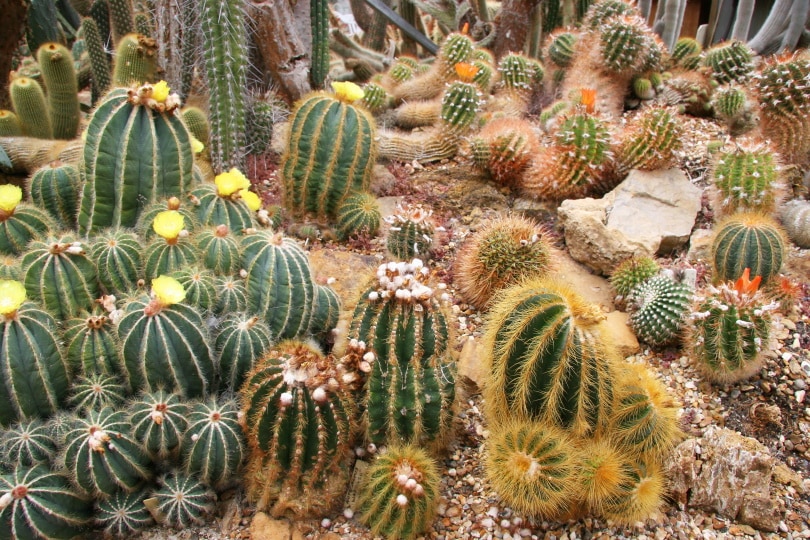
Cactus plants, especially those that produce flowers, can be a fantastic addition to your home or garden. They are succulents that are easy to maintain and grow and have several health benefits. Also, due to their unique appearance, they will surely be a conversation starter for anyone that enters your home.
We will cover some of the most beautiful Cactus Flowers and their characteristics and needs. If you ever considered planting cacti or would just like to know more about their varieties, you came to the right place.
The 16 Various Types of Cactus Flowers
1. Spider Cactus
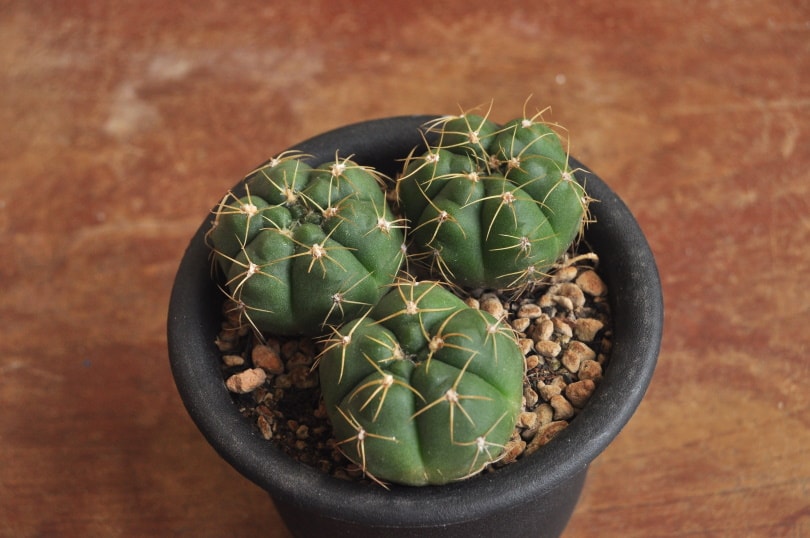
| USDA Hardiness Region | 10–11 |
| Soil | Well-drained, mildly acidic/alkaline |
| Sun | Partial shade |
| Flowering Time | Mid-summer |
The Spider Cactus (Gymnocalycium horstii) is a small, round-shaped cacti species that can be up to 4 inches high and reach 10 inches in diameter. This cactus specimen is unique due to its large flowers, which are usually pink, white, or pale purple.
They require weekly watering and are ideal indoor plants for small spaces. They can also be grown outside, but since they are not cold-resistant, you need to put them inside during the colder months of the year.
- Pretty easy to grow
- Ideal indoor plant
- Cannot grow outside in cold weather
2. Rosy Pincushion Cactus

| USDA Hardiness Region | 10–11 |
| Soil | Gritty, well-drained |
| Sun | Full sun/partial shade |
| Flowering Time | No season, they can come at any time of the year |
The Rosy Pincushion Cactus (Mammillaria zeilmanniana) got its name because it resembles a pincushion, with small spikes and pink flowers. Their flowers can also be red or even white on rare occasions. It usually reaches a height of 5 inches and is about 3 inches in diameter.
It’s best to plant the Rosy Pincushion Cactus as a houseplant, but it can also be in a sheltered, sunny patio area in summer or yearly if you live in warm climates.
- Doesn’t need a lot of watering
- Low maintenance
- Cannot survive a hard frost
3. Monk’s Hood Cactus

| USDA Hardiness Region | 9–10 |
| Soil | Well-drained |
| Sun | Full sun |
| Flowering Time | Summer |
The Monk’s Hood Cactus (Astrophytum ornatum) is a stunning cactus that can reach over 6 feet in its natural habitat. Still, it can only grow 1 foot tall if it’s not in those conditions. It takes about 10 years to reach maturity. The cacti bear flowers in the summer, which are yellow and around 3 inches long.
They need light watering because their roots can root from too much water. You should re-pot the Monk’s Hood Cactus at the start of the growing season so that it can reach its true potential. It’s best to grow it indoors as a houseplant.
- Requires light watering
- Cannot reach its true potential outside its natural habitat
4. Dwarf Chin Cactus
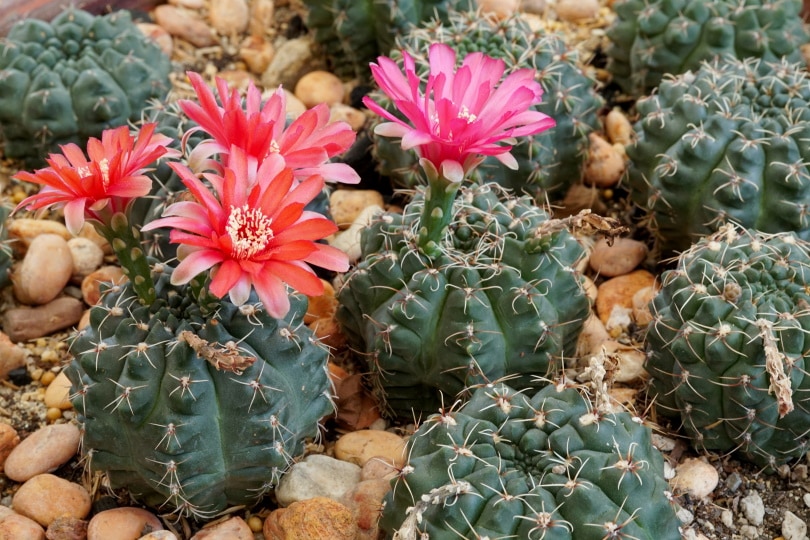
| USDA Hardiness Region | 8–11 |
| Soil | Gritty, well-drained |
| Sun | Filtered light/partial shade |
| Flowering Time | Early summer |
The Dwarf Chin Cactus (Gymnocalycium baldianum) is a small species of cacti that can grow up to 5 inches in diameter. It is a fast-growing cactus with red/purple flowers blooming during early summer.
They are pretty large and can be around 1.6 inches in diameter. These cacti require partial shade or filtered light if indoors to be able to grow properly. You need to water it frequently during summer, but during winter, watering is unnecessary.
- No need to water during winter
- Cannot be planted in sunny areas
5. Powder Puff Cactus

| USDA Hardiness Region | 9–11 |
| Soil | Well-drained, sandy |
| Sun | Full sun |
| Flowering Time | Summer |
The Powder Puff Cactus (Mammillaria bocasana) resembles the Rosy Pincushion Cactus. It’s a species that forms little puffs that bear flowers during summer. They grow to be around 4.8 inches high and have a diameter of 3.2 inches.
Their flowers are usually pink but can be yellow or white on rare occasions. This cactus has an outside USDA Hardiness Zone of 9–11, so if that doesn’t include your location, you need to plant them indoors.
- Unique appearance
- Can be grown outdoors only in USDA hardiness zones 9–11
6. Claret Cup Cactus
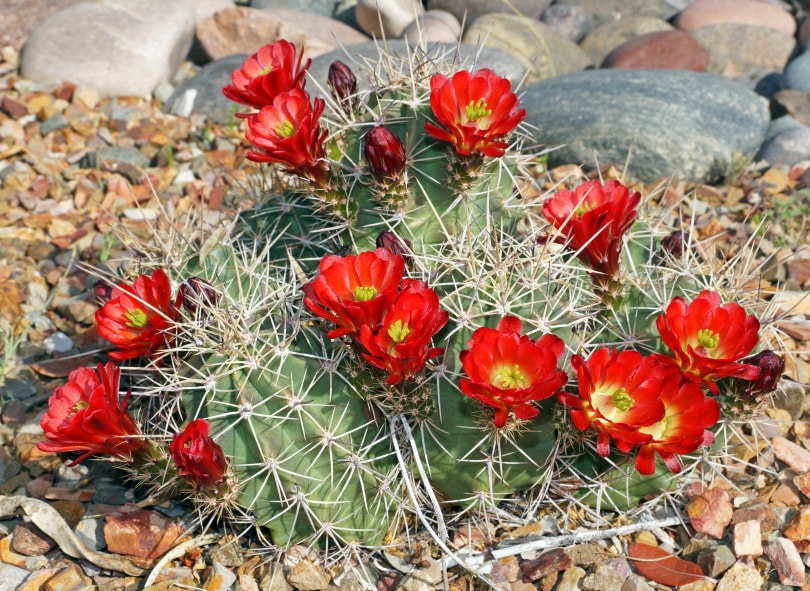
| USDA Hardiness Region | 9–10 |
| Soil | Gravel, dry |
| Sun | Full sun |
| Flowering Time | April, May |
The Claret Cup Cactus (Echinocereus triglochidiatus) is a cactus native to the southwest part of the US and Mexico. It is one of the most beautiful cacti species, with orange, red flowers that bloom during April and May.
Its height can reach 24 inches; the stems are around 10 inches long and about 4 inches in diameter. It needs to be watered regularly in hot months but shouldn’t be watered during wintertime. Overall, it’s a great outdoor and indoor plant that is easy to grow.
- Easy to grow
- Doesn’t require watering in winter months
- Cannot grow in shady areas
7. Balloon Cactus

| USDA Hardiness Region | 9–12 |
| Soil | Well-drained, acidic soil |
| Sun | Partial sun/shade |
| Flowering Time | Summer |
The Balloon Cactus ( Notocactus mafnificius) is, as the name says, a balloon-shaped cactus that is only suitable as a houseplant. It can be 12 inches high indoors, but wild specimens can grow up to 3 feet tall.
This cactus cannot tolerate frost. The flowers it produces are bright yellow and come in summer, but some might not flower. They are moderate growers, and reaching their true potential will take time.
- This cactus bears stunning yellow flowers
- Some might not have flowers
- Doesn’t tolerate frost
8. Fairy Castle Cactus

| USDA Hardiness Region | 10–11 |
| Soil | Well-drained soil |
| Sun | Full sun/partial shade |
| Flowering Time | Rarely |
The Fairy Castle Cactus (Cereus tetragonus) is one of the most unique cactuses that bear flowers. They got their name due to their resemblance to a fairy castle. It blooms rarely, which is sad because the flowers it bears are beautiful.
They are slowly growing, but they can grow over 6 feet tall. They require full sun and well-drained soil for the best growth. They are easy to care for and don’t require a lot of watering, making them perfect for first-time cactus owners.
- Really tall cactus
- Rarely blooms
9. Starfish Cactus

| USDA Hardiness Region | 9–11 |
| Soil | Well-drained soil |
| Sun | Full sun/direct light |
| Flowering Time |
The Starfish Cactus (Stapelia grandiflora) produces the largest flowers out of all cacti species. They are wide and shaped like stars, making them a perfect plant for any household. Their flowers are usually red, purple, green, and occasionally yellow.
One unappealing aspect of the flowers is that they have a terrible odor after a couple of days, so it might be best to keep them outside while they bloom. They need light to grow but are overall very low-maintenance plants.
- Magnificent, large flowers
- Low maintenance
- Flowers have a bad odor
10. Prickly Pear Cactus
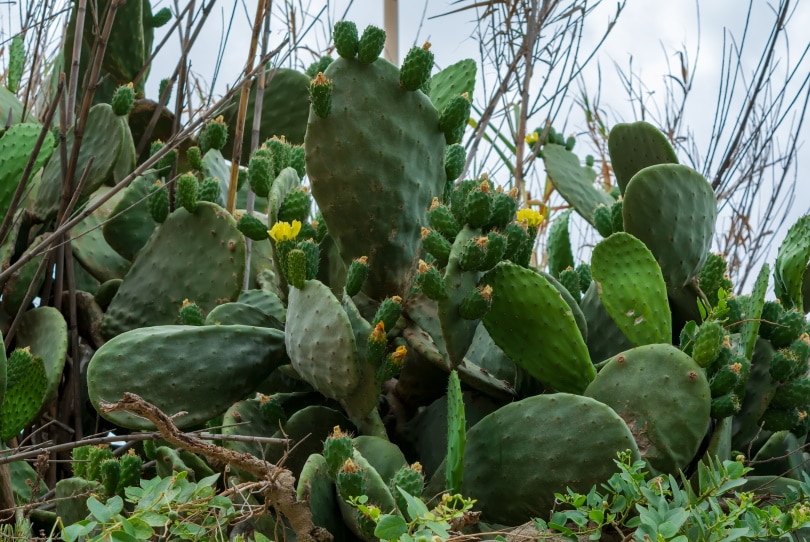
| USDA Hardiness Region | 9–11 |
| Soil | Well-drained, alkaline soil |
| Sun | Full sun |
| Flowering Time | June,July |
The Prickly Pear Cactus (Genus opuntia) is a variety that grows from 6–12 inches high, and they have an interesting appearance. They are flat-shaped and don’t require too much watering.
Their growth is relatively slow, and it can take over 4 years for them to bear flowers. Once they bloom, which happens around June/July, they have yellow, orange flowers. Certain species of this cactus have edible fruit.
- Doesn’t require too much watering
- Slow-growing cactus
11. Christmas Cactus
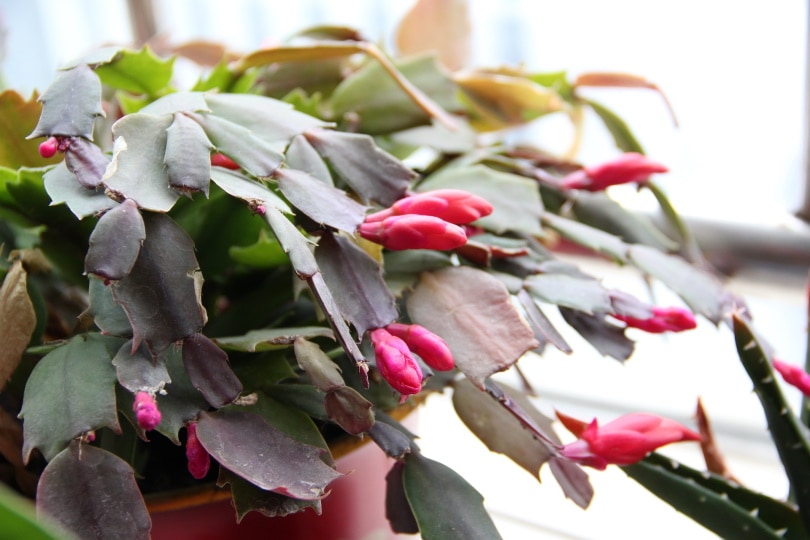
| USDA Hardiness Region | 10–12 |
| Soil | Well-drained, moist |
| Sun | Partial shade/indirect light |
| Flowering Time | Fall, early winter |
The Christmas Cactus (Schlumbergera bridgesii) is the perfect indoor plant, which got its name due to its fall and early winter blooming. This cactus bears beautiful rosy, pink flowers. It should be kept in a humid environment and misted a couple of times weekly.
They are usually around 6–12 inches tall and about 12–24 inches wide. It will surely be a showstopper in any household, so if you want an indoor cactus, the Christmas Cactus is an excellent option.
- Perfect indoor plant
- Needs humid environment
12. Easter Cactus

| USDA Hardiness Region | 10–11 |
| Soil | Acidic soil |
| Sun | Partial sun/full shade |
| Flowering Time | March, May |
The Easter Cactus (Hatiora gaertneri) is another houseplant that can easily fit into any home decor. It blooms from March until May with many vibrant flowers. They are quite large when mature and can be 2 feet tall and 2 feet wide.
They prefer cooler environments and cannot grow in hot environments as most usual cactuses can. They should be fertilized during winter but not during summer. This species needs to be re-poted every couple of years to refresh the soil.
- Large when mature
- Cannot grow in warm environments
- Needs reporting every couple of years
13. Peanut Cactus
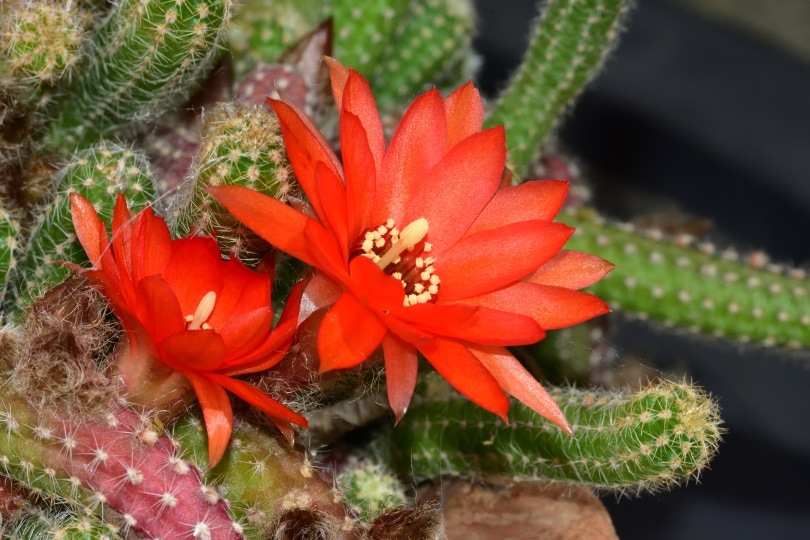
| USDA Hardiness Region | 10–11 |
| Soil | Well-drained, acidic soil |
| Sun | Full sun |
| Flowering Time | Spring, summer |
The Peanut Cactus (Echinopsis chamaecereus) is one of the rarest species. They seem prickly but are soft to the touch. The cactus is around 6 inches tall in its mature size. It blooms around spring or summer and has red, slightly orange flowers.
It’s a low-maintenance plant that can be grown outdoors and indoors. It requires cooler temperatures to prosper during summer but cannot stand frost. It requires full sun to prosper, like most other cacti.
- Low maintenance
- Cannot stand frost
14. Schlosser Cactus
| USDA Hardiness Region | 7–10 |
| Soil | Well-drained soil |
| Sun | Full/partial sun |
| Flowering Time | May |
The Schlosser Cactus (Notocactus schlosseri) is a species native to Uruguay but has become prevalent in the US in the last couple of years. It’s a cactus that grows slowly but is easy to maintain.
They can grow in hot and cold temperatures indoors and outdoors. They don’t need to be watered during winter, whereas they need some watering during summer. Their flowers are yellow, and they resemble small sunflowers.
- Easy to grow
- Doesn’t need watering during winter
- Needs to be put inside during colder months
15. BeaverTail Cactus
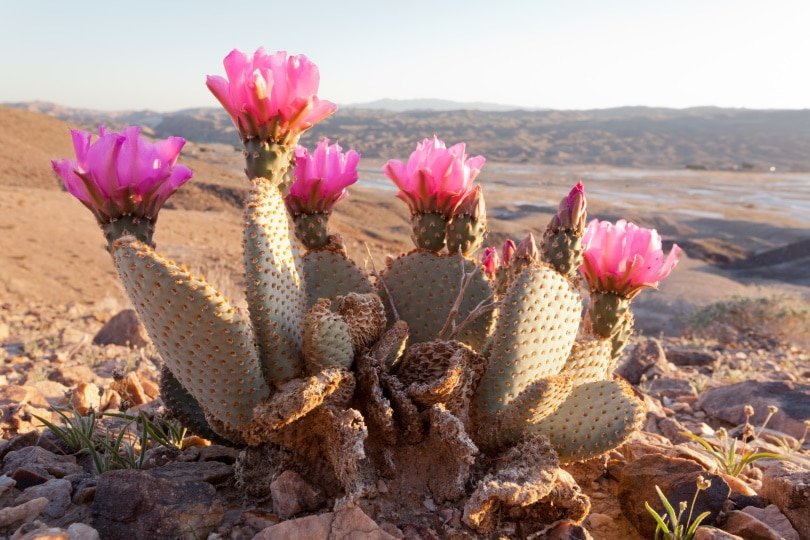
| USDA Hardiness Region | 8–10 |
| Soil | Well-drained, acidic, alkaline soil |
| Sun | Full sun |
| Flowering Time | Spring |
The Beavertail Cactus (Opuntia basilaris) is a succulent, low-spreading cactus with wide, flat pads, similar to Prickly Pear Cactus. This cactus is usually planted outside but should be inside during colder periods of the year.
They bear flowers in spring, and the flowers are usually red, pink, or purple. It is another low-maintenance species that doesn’t require lots of water to grow. They can be 2 feet tall and about 5 feet wide when mature.
- Low spreading
- Low maintenance
- Needs to be put inside during colder months
16. Calico Cactus

| USDA Hardiness Region | 5–9 |
| Soil | Sandy, well-drained soil |
| Sun | Full sun |
| Flowering Time | Spring |
The Calico cactus (Echinocereus engelmannii) is also known as Engelmann’s hedgehog cactus. It can grow up to 2 feet and is among the most common cactuses in the southwest USA. It blooms in spring and has pink and red flowers.
They are usually around ¼ inches long, and several appear once the cactus blooms. The Calico doesn’t require much water and must be planted in full sun. Their stems are upright but tend to fall to the ground with age.
- Easy to grow
- Stems can fall to the ground with age
Conclusion
Flowering cacti provide indoor and outdoor spaces with colorful displays. Some species take a few years to bloom, but the gorgeous flowers are worth the wait. Before planting a flowering cactus, ensure your climate is ideal for its growing conditions. Although most cacti are sun-loving plants that thrive in the heat, we discussed a few that can tolerate colder weather.
You might also like:
Featured Image Credit: Dirk M. de Boer, Shutterstock
Contents

